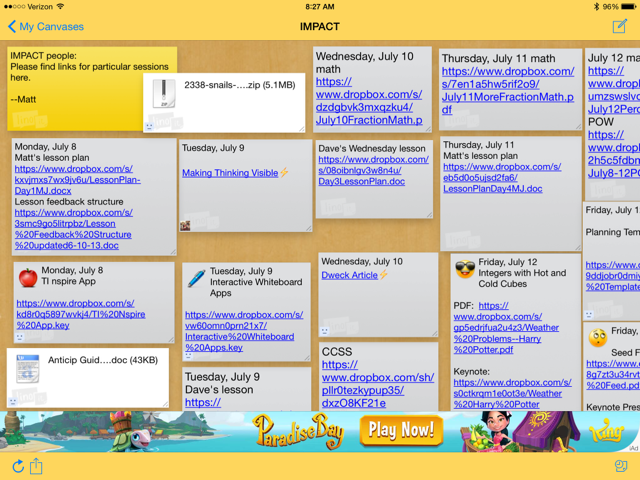IBL Workflow (Guest Blog by Matt Jones)
We are excited to continue our guest blog series with a blog by Matt Jones. We noticed during several IBL events that Matt knows a lot about technology tools that can be helpful in the IBL classroom, for instance a tool to create groups: Group Maker . So we asked him to share some of his ideas with our audience. The guest blogs will also point you to other existing IBL-related blogs, e.g. Matt's Blog. Read his blog for more ideas about technology and about teaching inquiry-based in general. Matt uses IBL in all his classes; his level of use of technology depends on what students have, and what equipment is available in the classroom.
Matt Jones
My name is Matt Jones. I am a professor in the mathematics department at California State University, Dominguez Hills, and the Associate Director for the Center for Innovation in STEM Education. I am heavily involved in mathematics education, so in addition to teaching regular courses for students at CSUDH, I also work on grants for professional development for mathematics teachers and college instructors.
I got to know the team at Discovering the Art of Mathematics through work that we have done with the Academy of Inquiry-Based Learning ( www.inquirybasedlearning.org). They asked me to share some of how I use technology in conjunction with my work.
A few years ago, I got involved in a professional development project for middle school mathematics teachers where all of us were using iPads. Partially as an outgrowth of that project, I started a blog called The Math Switch (http://themathswitch.blogspot.com ). In this post, I am going to detail the workflow that emerged in the first year of the project.
iPad workflow in a math classroom
I will explain the basic structure of how assignments are "handed out," students work on them, and turn them in for my one-to-one iPad classroom. All of the apps mentioned are linked to the iPad App Store (https://www.apple.com/app-store/), though many of them can also be used on Android, or have analogous apps. [Eds. Given the rapid development of Apps in the store, we have removed direct links to the Apps. We recommend that you search the App Store directly.]
To share an assignment, I start by creating a PDF of a problem set, and putting it in Dropbox. (Note that sometimes I took advantage of technology and launched a problem with a photo or short video clip.)
The easiest way to create a place to share links is to create a Lino board for the classroom (for our purposes, call the board "Math with iPads"). Then, I create a link to the Math with iPads board, and send the link to the (Lino) board to the class via email. Once all the students have the link to the Math with iPads Lino board, they copy it onto a virtual sticky on a Lino board of their own (either the "Main" board, or just by creating a board). This enables the students to quickly get to links to various handouts.
Now, in Dropbox, I create a link to my PDF, and put it on the Lino board. (If the lesson begins from another source, I would instead share that link.) The students open their Lino app, and click through the link to the Math with iPads board, and from there link to the Dropbox PDF.
Now students have a PDF, but since we are doing math, they usually want to write on it. There are tons of apps for writing on a PDF file, but we used NotesPlus and Notability most. They both have a lot of features, including a zoom-in box that allows you to make your writing small enough for the page, but without needing to make the page so large that you cannot read the problem.
When students have completed their problems, there are two different goals for collecting work from students. In the first case, I want to have students share what they have done with the class. In this case, not every student will be turning in their work to me. For this case, we found Baiboard to be convenient. Baiboard is a shared whiteboard on which you can write, but also import photos. In this case, as the instructor, I would open a Baiboard, which gives me a board number. I then share the board number with students, and ask particular students to post screenshots (photos of their work on the iPad) on particular pages of the board. Once the photo is loaded, anyone who logs in to the app, including me, the student who loaded the screenshot, or anyone else who logged in, can write on the board, including writing on the photo. So I am at the front of the room, projecting the Baiboard on the class projector for all to see, and the student and I are both able to add annotations to the work the student has posted on the board.
In the second case, I want all students to submit their work, as would typically be done with homework, for example. In that case, students take their work from NotesPlus, export it as a PDF in their Dropbox. Then they can either attach the PDF to an email addressed to me, or send me the file link so that I can see their work in their Dropbox.
If I want to comment and return the work, I need to open their PDF in my own NotesPlus to make comments, and repeat the process of exporting the NotesPlus notebook to PDF and sending back to the student.
Over the three years of the project, our workflow evolved, for instance we moved away from Dropbox and toward Google Drive. But that's a discussion for another post.


